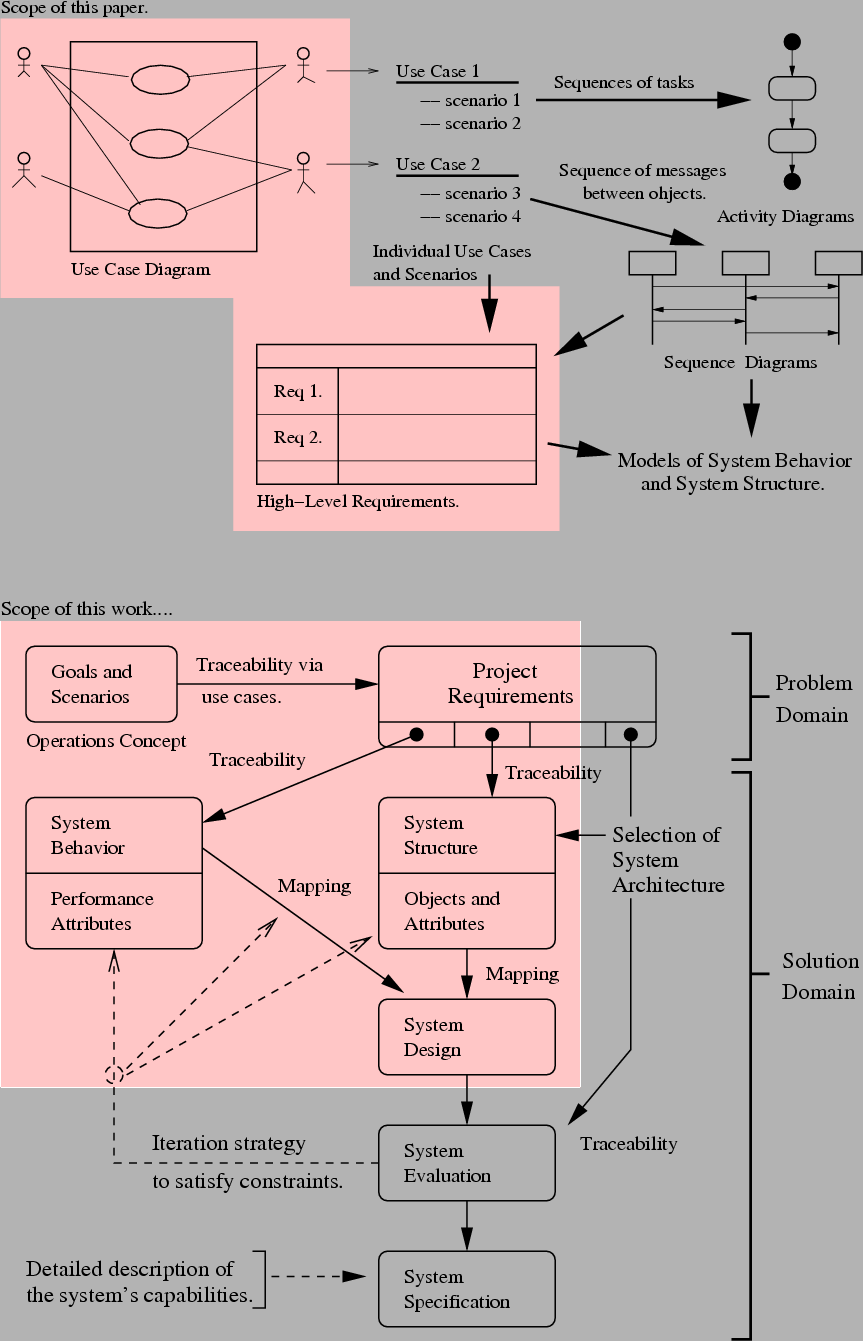Figure 2.1:
Pathway from Operations Concept to
Models of Behavior/Structure to Requirements
Figure 2.2:
Traceability Mappings for the Development Pathway,
Goals/Scenarios through System Evaluation (Source: Austin/Baras [6])
 |
A good system design provides:
(1) A desirable balance of functionality, performance, and economy,
(2) A pathway to convenient and reliable operation in a wide range of environments, and
(3) Ease of accommodation for future expansion and technical improvements.
Assessment procedures need to consider not only metrics
on the system functionality, performance, and economy,
but the potential impact develops will have on
the existing infrastructure and environment.
To maximize the likelihood of development efforts staying on track,
most complex engineering systems are developed within the framework of
an agreed upon (or established) process.
Figures 2.1 through 2.3
illustrate the step-by-step procedure for front-end systems development
that will guide this project.
Points to note are as follows [6]:
- 1.
At the front-end of development, systems
engineers are concerned primarily with system functionality
and identification of the key environmental conditions
within which this functionality must occur. Therefore,
models of system functionality need to describe what the
system will do under both normal and abnormal operating conditions.
Answers to these basic concerns are commonly expressed as functional requirements.
Performance requirements describe how well a system should perform these functions.
And economic requirements place constraints on the resources that
will be made available to develop and operate the system.
- 2.
Top-down development of system-level models begins with use cases,
and proceeds to fragments of system behavior,
expressed as activity and sequence diagrams.
Requirements are organized according to the role they
will play in the system-level design.
For example, some requirements will be
directed towards the system behavior because
they place constraints on minimum/maximum levels of
acceptable functional performance.
- 3.
Models of behavior specify what the system will actually do.
Usually, behavior can be represented as networks and hierarchies of tasks,
functions and processes.
Behavior is evaluated via attributes of performance.
Models of structure specify how the system will
accomplish its purpose. The system structure corresponds to
collections of interconnected objects and subsystems,
constrained by the environment within which the system must exist.
The nature of each object/subsystem will be captured by its attributes.
- 4.
We create the system-level design by mapping fragments
of system behavior onto specific subsystems/objects in the system structure.
Thus, the behavior-to-structure mapping defines the functional
responsibility of each subsystem/component.
System-level designs are typically viewed as collections of large,
arbitrarily complex functional units,
forming the major components of a system.
Connections among units may be arbitrarily complex,
carrying unspecified data and information.
- 5.
In the system evaluation, performance and characteristics of the
system-level design are evaluated against the test requirements.
Several iterations of development may be needed to modify the system behavior,
system structure, perhaps even the original operations concept,
and achieve a design that satisfies all of the system-level requirements.
- 6.
The system-level specification is a detailed
description of the system's capabilities (or required capabilities).
The activities in Figure 2.2 are repeated for
each level of system development (i.e., system level; sub-system level;
component level).
Specialization for Arcology Development. Figures
2.1 and 2.2 define a
general-purpose process for the development of systems, independent of
the participating disciplines. When discipline-specific knowledge is
added to the design of appropriate development processes, some problems
become more difficult, others easier.
For arcology development, models of system structure are simplified
through the structured decomposition of the human habitat into groups of
subsystems. Performance metrics capture the essential details of
resource flows, which in turn, allow for the comparison of different
types of arcologies to actual living conditions. As illustrated in
Figure 2.3, a distinguishing feature of
arcology evaluation is the significant role pre-existing environment and
transportation infrastructure conditions play in system assessment. By
itself, a new system may have adequate functionality, performance and
cost. But if its impact on the pre-existing infrastructure is
unacceptable, then it is unlikely the new development will be approved.
A proper evaluation requires models for both the new system and the
environment in which it will be placed.
Figure 2.3:
Model and Evaluation of New Development and Impact on Pre-Existing Infrastructure
 |
Rowin Andruscavage
2007-05-22
